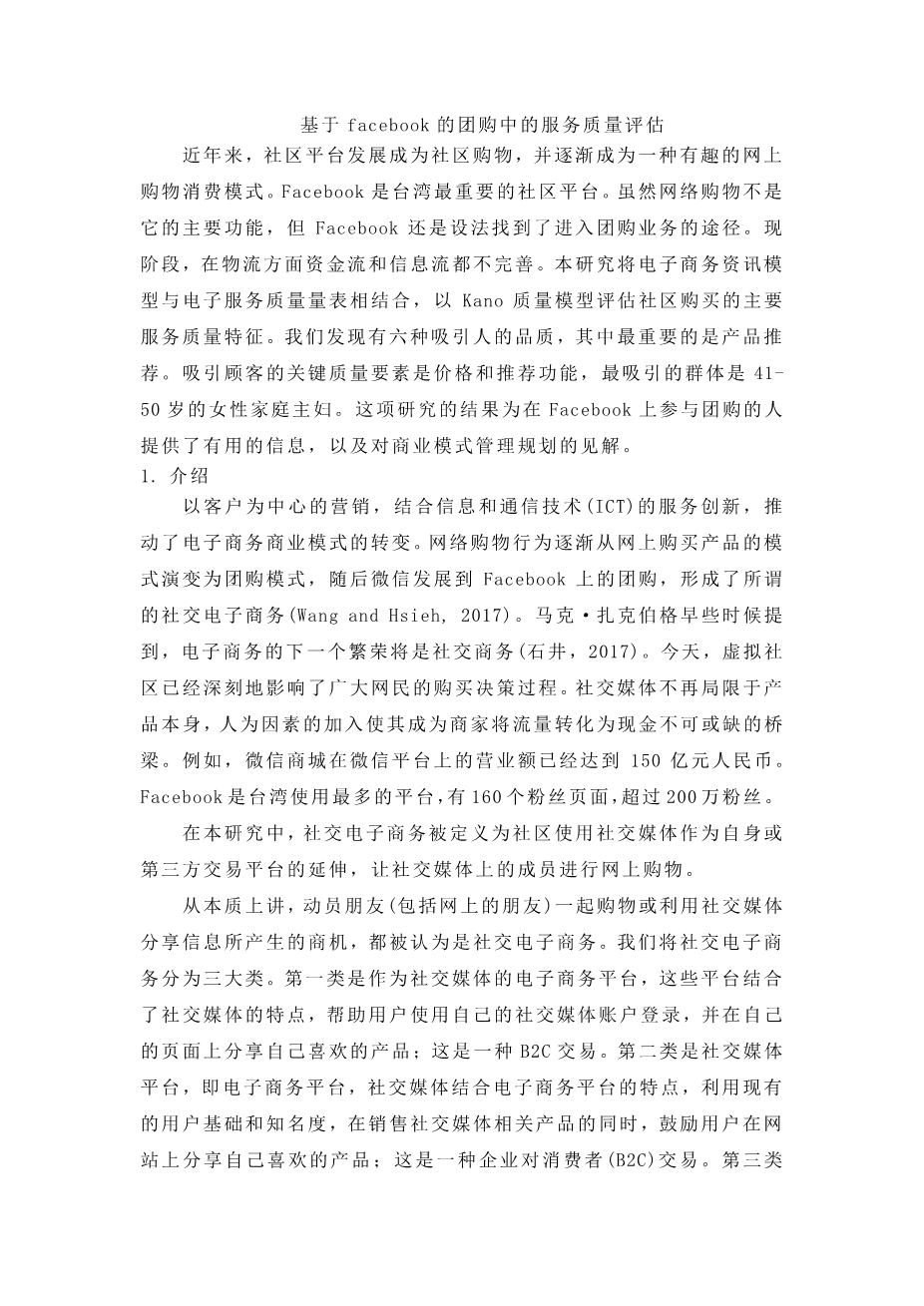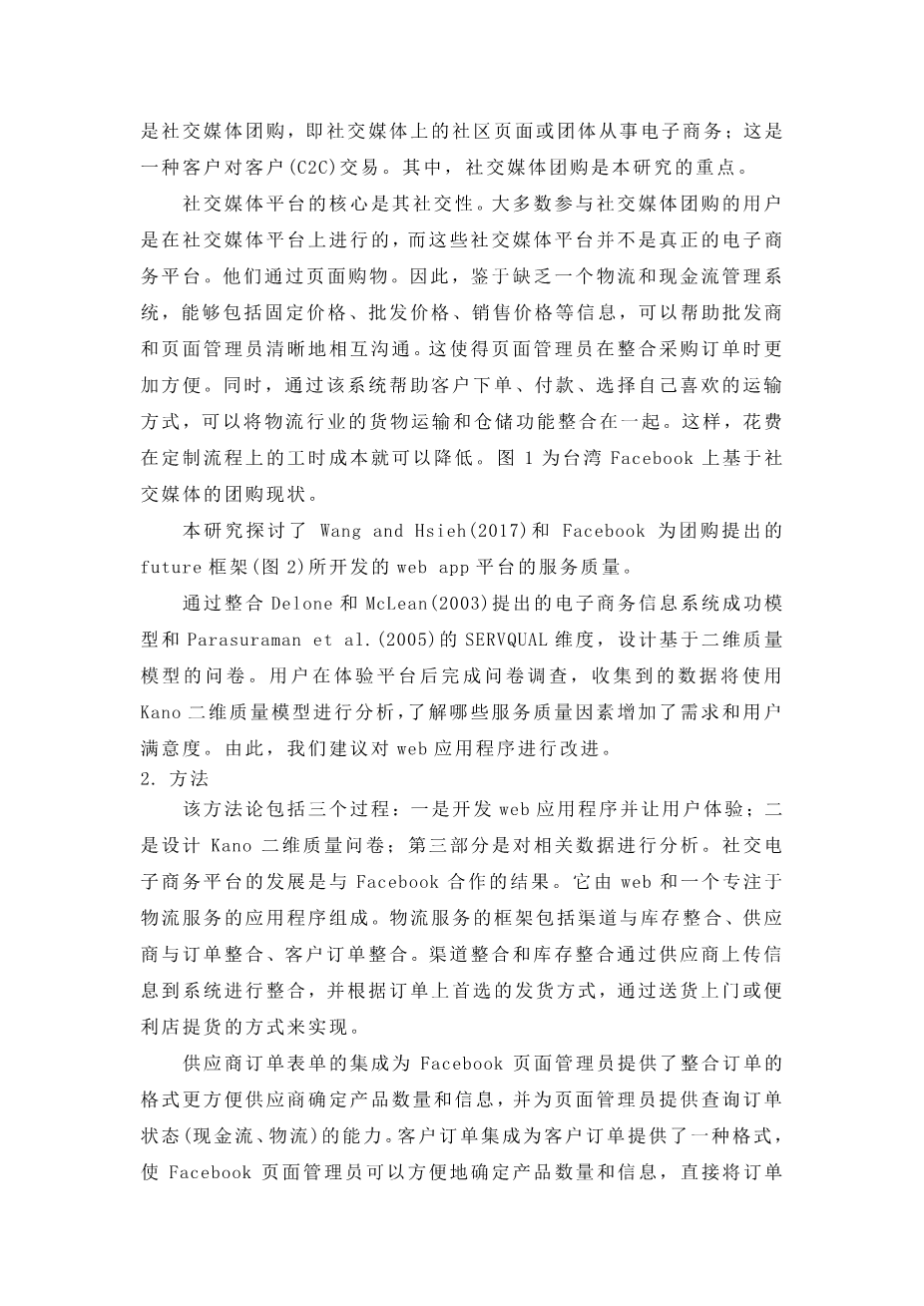Evaluation of service quality in facebook-based group-buying
abstract
In recent years, community platforms have developed into community shopping, and have gradually become an interesting online shopping consumption model. Facebook is Taiwanrsquo;s most important community platform. Internet shopping is not its main function though, but still Facebook has managed to find a way into the group-buying business. At this stage, in its logistics, the financial flows and information flows are not perfect. This study integrates a model of e-commerce information with an electronic service quality scale, and uses the Kano quality model to assess the key service quality characteristics of community buying. We found that there are six attractive qualities, the most important of which is product recommendation. The key quality elements for attracting customers are price and recommendation features, and that the group that is most attracted are 41- to 50-year-old female home-makers. The results of this research provide people who participating in group-buying on Facebook with useful information on the process, as well as insights on managerial planning for the business model.
1. Introduction
Customer-centric marketing, combined with service innovation from information and communications technology (ICT), has driven the transformation of the e-commerce business model. Online shopping behavior has gradually evolved from the model of purchasing products online into a group-buying model, which was followed closely by the development of WeChat to group-buying on Facebook, forming the so-called social e-commerce (Wang and Hsieh, 2017). Mark Zuckerberg earlier mentioned that the next boom in e-commerce would be social commerce (Ishii, 2017). Today, virtual communities have already deeply impacted the buying decision process of the majority of Internet users. No longer limited by the products themselves, the addition of human factors have made social media into an indispensable bridge for businesses to convert their traffic into cash. The turnover at the WeChat Mall on the WeChat platform has reached RMB 15 billion, for example. Facebook, the most used platform in Taiwan, has 160 fans pages with more than 2 million followers.
In this research, social e-commerce is defined as communities that use social media as an extension of their own or third-party trading platforms to get members in social media to shop online.
Essentially, the business opportunities derived from the mobilization of friends (including online friends) to make purchases together or the use of social media to share information are all considered to be social e-commerce. We divide social e-commerce into three main categories. The first category consists of e-commerce platforms as social media wherein these platforms combine the features of social media to help users log in using their social media accounts and share the products they like on their own page; this is a type of B2C transaction. The second category consists of social media platforms as e-commerce platforms wherein social media combine the features of e-commerce platforms to use their existing user base and popularity to, aside from selling products related to the social media, encourage users to share the products they like on the website; this is a type of business-to-consumer (B2C) transaction. The third category consists of social media groupbuying, with community pages or groups on social media engage in e-commerce; this is a type of customer-to-customer (C2C) transaction. Among these, social media group-buying is the primary focus of this research.
At the core of social media platforms is its social aspect. Most users that engage in social media group-buying do so on social media platforms that are not bona fide e-commerce platforms. They make their purchases through pages. Therefore, given the lack of a logistics and a cash flow management system, capable of including fixed price, wholesale price, selling price, and other such information, can help wholesalers and page administrators communicate clearly with each other. This makes it more convenient for page administrators in consolidating purchase orders. Also, using the system to help customers book their orders, make payments, and select their preferred shipping method means that the system can integrate the goods shipment and storage functions of the logistics industry. With this, the cost of person hours spent on customized processes can be reduced. Fig. 1 shows the current status of social media-based group-buying on Facebook in Taiwan.
This research explores the service quality of the web app platform developed from the work of Wang and Hsieh (2017) and the To-Be framework (Fig. 2) proposed by Facebook for group buying.
By consolidating the e-commerce information systems success model proposed by Delone and McLean (2003) and the SERVQUAL dimensions of Parasuraman et al. (2005), a questionnaire based on the two-dimensional quality model is designed. After users completed the questionnaire after experiencing the platform, the data collected will be analyzed using the Kano two-dimensional quality model to understand which of the service quality factors increase demand and user satisfaction. From this, we propose improvements to the web app.
2. Methodology
The methodology consists of three processes: the first is the development of the web app and to have users experience it; the second is to design a Kano two-dimensional quality questionnaire; and the third is to conduct some related data analysis. The development of the social e-commerce platform occurred in cooperation with Facebook. It consists of the web and an app focusing on logistic services. The framework of logistic services includes channel and inventory integration, supplier and order integration, and customer order integration. Channel integration and inventory integration are achieved through
剩余内容已隐藏,支付完成后下载完整资料


英语译文共 8 页,剩余内容已隐藏,支付完成后下载完整资料
资料编号:[258746],资料为PDF文档或Word文档,PDF文档可免费转换为Word
您可能感兴趣的文章
- 基于4P模型和品牌的路易威登中国营销策略分析外文翻译资料
- “互联网 ”背景下的电子商务对国际经济和贸易的影响外文翻译资料
- 四川达州农村电商生态系统建设中的问题与对策外文翻译资料
- 品牌年轻化策略对消费者购买意愿的影响研究外文翻译资料
- 后疫情时代咖啡企业新零售营销策略研究——以瑞幸为例外文翻译资料
- 中国精品咖啡电商市场营销研究 ——基于消费者行为视角外文翻译资料
- 基于社交网络的跨境电商用户购买行为影响因素的实验探索——以小红书为例外文翻译资料
- 基于数据仓库的培训机构信息管理系统的设计与实现外文翻译资料
- 支持在线学习环境和慕课中的自我调节学习:系统综述外文翻译资料
- 中日韩FTA对中国制造业的影响研究外文翻译资料


